Measuring Urban and Landscape Change Due to Sea Level Rise: Case Studies in Southeastern USA
Abstract
1. Introduction
- This research addressed a critical gap in SLR studies for coastal landscape assessment, planning, and decision-making by incorporating remote sensing-based land-use/land-cover changes, mapped with regional and comprehensive SLR scenarios projected up to the year 2100 [6];
- In addition to maps, our analysis also quantified natural landscape and urban changes based on numerical landscape metrics, enabling objective comparisons and statistical summaries beyond visual map interpretations.
- The geospatial methodology and findings utilizing remote sensing data in this study served not only as a reference for comprehensive planning but also as a basis for crafting distinct adaptation strategies for urban and natural landscapes.
2. Literature Review
2.1. Sea Level Rise (SLR) Scenarios
2.2. Natural Landscape and Urban Metrics
3. Materials and Methods
3.1. Study Areas
3.2. Data Resources and Landscape Metrics
3.3. Methods
3.3.1. Core Habitats Identification
- For core habitats when SLR is lower than 3 feet: (1) Select the wetlands classified as core habitats. (2) Integrate the core wetlands with other core areas that are not susceptible to ocean submersion. (3) Identify remaining areas that are capable of meeting the “core habitat” criteria. (4) Incorporate maps into FRAGSTATS [13] and perform metric calculations;
- For core habitats when SLR is higher than 3 feet: (1) Identify core habitats unaffected by SLR. (2) Integrate maps into FRAGSTATS [13] and compute relevant metrics.
3.3.2. Mapping Urban and Landscape Changes under SLR Scenarios
3.3.3. Quantifying Urban and Landscape Change by Metrics
4. Results
4.1. Core Habitats Identification
4.1.1. St. Johns County Core Habitat Identification
4.1.2. Chatham County Core Habitat Identification
4.1.3. Comparison of Landscape Metric Changes between the Two Counties
4.2. Urban Built Area Change Identification
4.2.1. St. Johns County Urban Built Area
4.2.2. Chatham County Urban Built Area
4.2.3. Comparison of Urban Metric Changes between the Two Counties
5. Discussion
5.1. Core Habitat Change in the Two Counties
5.2. Built Area Change in the Two Counties
6. Conclusions
Author Contributions
Funding
Institutional Review Board Statement
Informed Consent Statement
Data Availability Statement
Conflicts of Interest
Abbreviations
| ENN_MN | Mean Euclidean nearest-neighbor distance |
| FRAC_AM | Area-weighted mean patch fractal dimension |
| GMSL | Global Mean Sea Level |
| LPI | Largest patch index |
| MDPI | Multidisciplinary Digital Publishing Institute |
| NOAA | National Oceanic and Atmospheric Administration |
| NP | Number of patches |
| PD | Patch density |
| PLADJ | Percentage of like adjacencies |
| PLAND | Percentage of landscape |
| SHAPE_MN | Mean patch shape index |
| SLR | Sea level rise |
| TA | Total area |
Appendix A
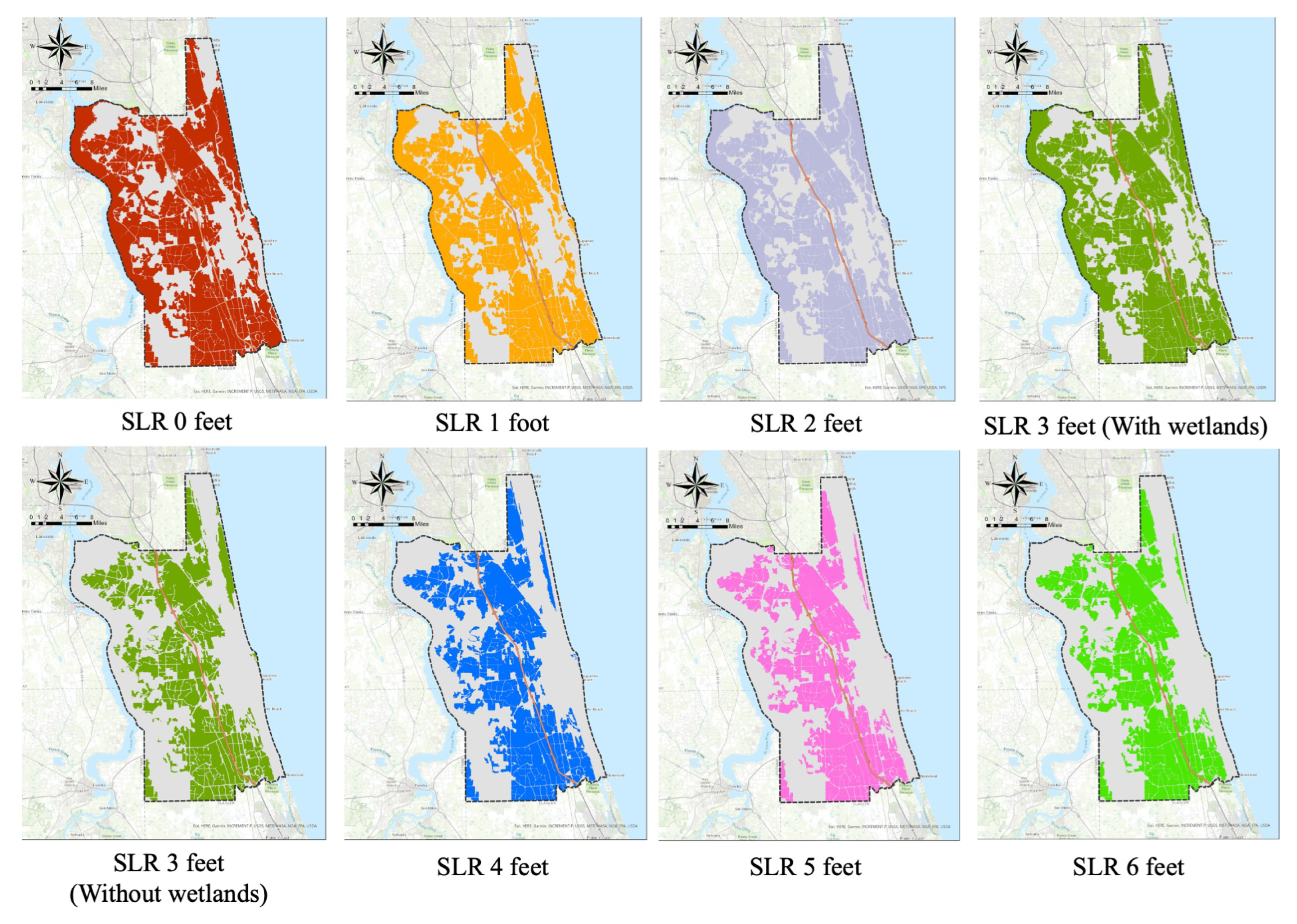

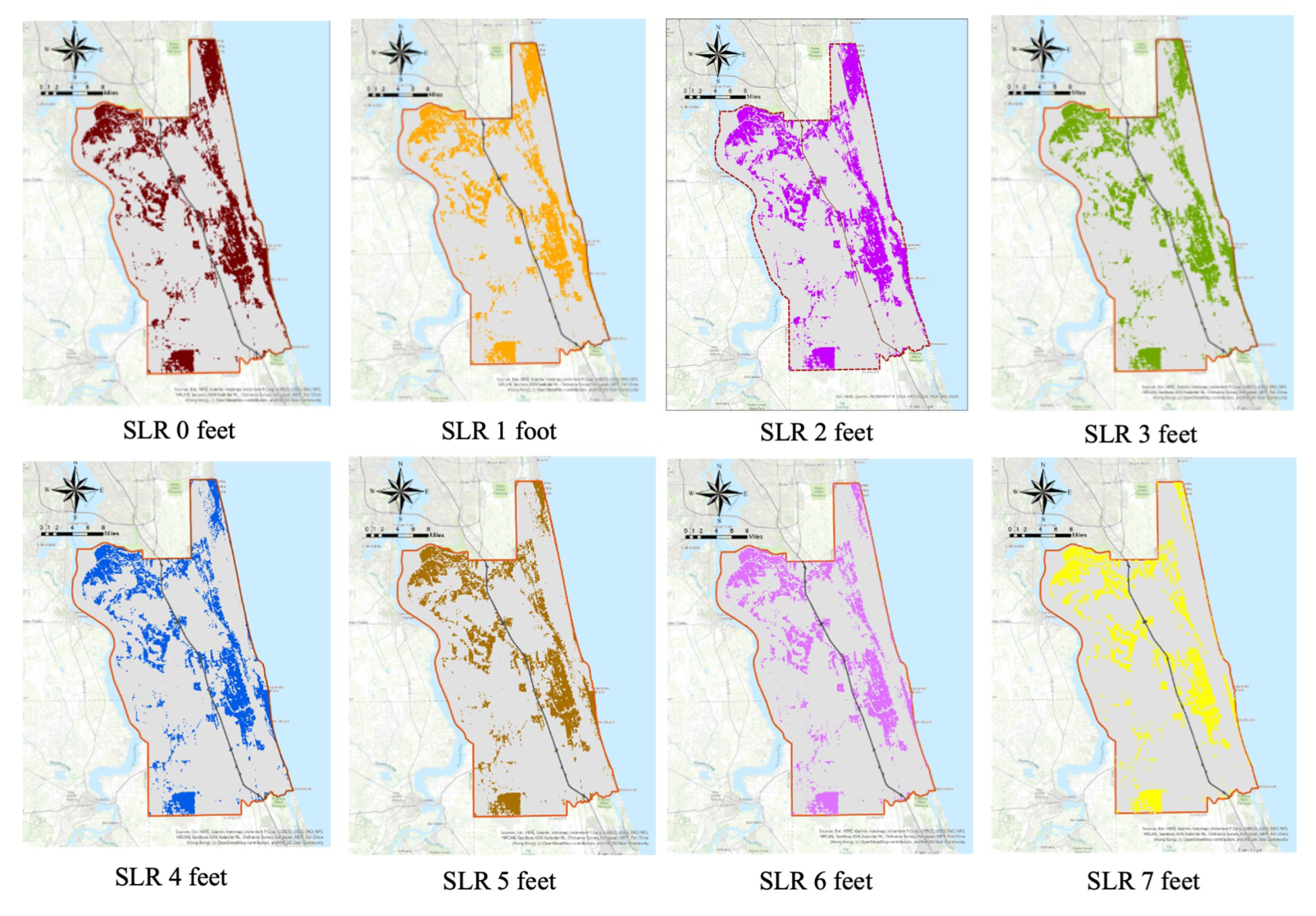

References
- Hauer, M.E.; Evans, J.M.; Mishra, D.R. Millions projected to be at risk from sea-level rise in the continental United States. Nat. Clim. Chang. 2016, 6, 691–695. [Google Scholar] [CrossRef]
- Bhattachan, A.; Jurjonas, M.D.; Moody, A.C.; Morris, P.R.; Sanchez, G.M.; Smart, L.S.; Taillie, P.J.; Emanuel, R.; Seekamp, E. Sea level rise impacts on rural coastal social-ecological systems and the implications for decision making. Environ. Sci. Policy 2018, 90, 122–134. [Google Scholar] [CrossRef]
- NOAA Sea Level Rise Viewer. Available online: https://coast.noaa.gov/slr/ (accessed on 9 January 2024).
- Surging Seas: Risk Zone Map. Available online: https://ss2.climatecentral.org/#12/40.7298/-74.0070?show=satellite&projections=0-K14_RCP85-SLR&level=5&unit=feet&pois=hide (accessed on 9 January 2024).
- Parris, A.S.; Bromirski, P.; Burkett, V.; Cayan, D.R.; Culver, M.E.; Hall, J.; Horton, R.M.; Knuuti, K.; Moss, R.H.; Obeysekera, J.; et al. Global Sea Level Rise Scenarios for the United States National Climate Assessment. 2012. Available online: https://repository.library.noaa.gov/view/noaa/11124 (accessed on 8 June 2024).
- Sweet, W.V.; Hamlington, B.D.; Kopp, R.E.; Weaver, C.P.; Barnard, P.L.; Bekaert, D.; Brooks, W.; Craghan, M.; Dusek, G.; Frederikse, T.; et al. Global and Regional Sea Level Rise Scenarios for the United States: Updated Mean Projections and Extreme Water Level Probabilities along US Coastlines; National Oceanic and Atmospheric Administration: Silver Spring, MD, USA, 2022; Available online: https://aambpublicoceanservice.blob.core.windows.net/oceanserviceprod/hazards/sealevelrise/noaa-nos-techrpt01-global-regional-SLR-scenarios-US.pdf (accessed on 8 June 2024).
- Morris, J.T.; Sundareshwar, P.; Nietch, C.T.; Kjerfve, B.; Cahoon, D.R. Responses of coastal wetlands to rising sea level. Ecology 2002, 83, 2869–2877. [Google Scholar] [CrossRef]
- Temmerman, S.; Govers, G.; Meire, P.; Wartel, S. Modelling long-term tidal marsh growth under changing tidal conditions and suspended sediment concentrations, Scheldt estuary, Belgium. Mar. Geol. 2003, 193, 151–169. [Google Scholar] [CrossRef]
- D’Alpaos, A.; Lanzoni, S.; Marani, M.; Rinaldo, A. Landscape evolution in tidal embayments: Modeling the interplay of erosion, sedimentation, and vegetation dynamics. J. Geophys. Res. Earth Surf. 2007, 112. [Google Scholar] [CrossRef]
- Kirwan, M.L.; Murray, A.B. A coupled geomorphic and ecological model of tidal marsh evolution. Proc. Natl. Acad. Sci. USA 2007, 104, 6118–6122. [Google Scholar] [CrossRef] [PubMed]
- Mudd, S.M.; Howell, S.M.; Morris, J.T. Impact of dynamic feedbacks between sedimentation, sea-level rise, and biomass production on near-surface marsh stratigraphy and carbon accumulation. Estuar. Coast. Shelf Sci. 2009, 82, 377–389. [Google Scholar] [CrossRef]
- Kirwan, M.L.; Guntenspergen, G.R.; d’Alpaos, A.; Morris, J.T.; Mudd, S.M.; Temmerman, S. Limits on the adaptability of coastal marshes to rising sea level. Geophys. Res. Lett. 2010, 37. [Google Scholar] [CrossRef]
- McGarigal, K. FRAGSTATS: Spatial Pattern Analysis Program for Quantifying Landscape Structure; US Department of Agriculture, Forest Service, Pacific Northwest Research Station: Washington, DC, USA, 1995; Volume 351. [Google Scholar]
- Li, X.; Lu, L.; Cheng, G.; Xiao, H. Quantifying landscape structure of the Heihe River Basin, north-west China using FRAGSTATS. J. Arid. Environ. 2001, 48, 521–535. [Google Scholar] [CrossRef]
- Olsen, L.M.; Dale, V.H.; Foster, T. Landscape patterns as indicators of ecological change at Fort Benning, Georgia, USA. Landsc. Urban Plan. 2007, 79, 137–149. [Google Scholar] [CrossRef]
- Kamusoko, C.; Aniya, M. Land use/cover change and landscape fragmentation analysis in the Bindura District, Zimbabwe. Land Degrad. Dev. 2007, 18, 221–233. [Google Scholar] [CrossRef]
- Singh, S.K.; Srivastava, P.K.; Szabó, S.; Petropoulos, G.P.; Gupta, M.; Islam, T. Landscape transform and spatial metrics for mapping spatiotemporal land cover dynamics using Earth Observation data-sets. Geocarto Int. 2017, 32, 113–127. [Google Scholar] [CrossRef]
- Smiraglia, D.; Ceccarelli, T.; Bajocco, S.; Perini, L.; Salvati, L. Unraveling landscape complexity: Land use/land cover changes and landscape pattern dynamics (1954–2008) in contrasting peri-urban and agro-forest regions of northern Italy. Environ. Manag. 2015, 56, 916–932. [Google Scholar] [CrossRef] [PubMed]
- Zhang, Z.; Meerow, S.; Newell, J.P.; Lindquist, M. Enhancing landscape connectivity through multifunctional green infrastructure corridor modeling and design. Urban For. Urban Green. 2019, 38, 305–317. [Google Scholar] [CrossRef]
- Singh, S.K.; Pandey, A.C.; Singh, D. Land use fragmentation analysis using remote sensing and Fragstats. In Remote Sensing Applications in Environmental Research; Springer: Berlin/Heidelberg, Germany, 2014; pp. 151–176. [Google Scholar]
- Uuemaa, E.; Antrop, M.; Roosaare, J.; Marja, R.; Mander, Ü. Landscape metrics and indices: An overview of their use in landscape research. Living Rev. Landsc. Res. 2009, 3, 1–28. [Google Scholar] [CrossRef]
- Wurm, M. Oliveira, Vítor (2016): Urban Morphology. An Introduction to the Study of the Physical Form of Cities; The Urban Book Series; XXIII. 192 Seiten, 46 s/w-Illustrationen, 19 Farbige Illustrationen; Springer International Publishing: Cham, Switzerland, 2017. [Google Scholar]
- Hurlimann, A.; Barnett, J.; Fincher, R.; Osbaldiston, N.; Mortreux, C.; Graham, S. Urban planning and sustainable adaptation to sea-level rise. Landsc. Urban Plan. 2014, 126, 84–93. [Google Scholar] [CrossRef]
- Borchert, S.M.; Osland, M.J.; Enwright, N.M.; Griffith, K.T. Coastal wetland adaptation to sea level rise: Quantifying potential for landward migration and coastal squeeze. J. Appl. Ecol. 2018, 55, 2876–2887. [Google Scholar] [CrossRef]
- Christie, D.R. Florida’s ocean future: Toward a state ocean policy. J. Land Use Environ. Law 1989, 5, 447. [Google Scholar]
- Dovey, K.; Pafka, E.; Ristic, M. Mapping Urbanities: Morphologies, Flows, Possibilities; Routledge: London, UK, 2017. [Google Scholar]
- Pörtner, H.O.; Roberts, D.; Tignor, M.; Poloczanska, E.; Mintenbeck, K.; Alegría, A.; Craig, M.; Langsdorf, S.; Löschke, S.; Möller, V.; et al. (Eds.) Climate Change 2022: Impacts, Adaptation and Vulnerability. Contribution of Working Group II to the Sixth Assessment Report of the Intergovernmental Panel on Climate Change; Cambridge University Press: Cambridge, UK; New York, NY, USA, 2022; p. 3056. [Google Scholar] [CrossRef]
- The NASA Sea Level Projection Tool. Available online: https://sealevel.nasa.gov/ipcc-ar6-sea-level-projection-tool (accessed on 31 May 2024).
- Hinkel, J.; Jaeger, C.; Nicholls, R.J.; Lowe, J.; Renn, O.; Peijun, S. Sea-level rise scenarios and coastal risk management. Nat. Clim. Chang. 2015, 5, 188–190. [Google Scholar] [CrossRef]
- Kupfer, J.A. Landscape ecology and biogeography: Rethinking landscape metrics in a post-FRAGSTATS landscape. Prog. Phys. Geogr. 2012, 36, 400–420. [Google Scholar] [CrossRef]
- Guan, Y.; Lu, H.; He, L.; Adhikari, H.; Pellikka, P.; Maeda, E.; Heiskanen, J. Intensification of the dispersion of the global climatic landscape and its potential as a new climate change indicator. Environ. Res. Lett. 2020, 15, 114032. [Google Scholar] [CrossRef]
- Jaafari, S.; Shabani, A.A.; Moeinaddini, M.; Danehkar, A.; Sakieh, Y. Applying landscape metrics and structural equation modeling to predict the effect of urban green space on air pollution and respiratory mortality in Tehran. Environ. Monit. Assess. 2020, 192, 412. [Google Scholar] [CrossRef] [PubMed]
- Das, S.; Angadi, D.P. Assessment of urban sprawl using landscape metrics and Shannon’s entropy model approach in town level of Barrackpore sub-divisional region, India. Model. Earth Syst. Environ. 2021, 7, 1071–1095. [Google Scholar] [CrossRef]
- Bosch, M.; Jaligot, R.; Chenal, J. Spatiotemporal patterns of urbanization in three Swiss urban agglomerations: Insights from landscape metrics, growth modes and fractal analysis. Landsc. Ecol. 2020, 35, 879–891. [Google Scholar] [CrossRef]
- Bianchin, S.; Richert, E.; Heilmeier, H.; Merta, M.; Seidler, C. Landscape metrics as a tool for evaluating scenarios for flood prevention and nature conservation. Landsc. Online 2011, 25, 1–11. [Google Scholar] [CrossRef]
- Epting, S.M.; Hosen, J.D.; Alexander, L.C.; Lang, M.W.; Armstrong, A.W.; Palmer, M.A. Landscape metrics as predictors of hydrologic connectivity between Coastal Plain forested wetlands and streams. Hydrol. Process. 2018, 32, 516–532. [Google Scholar] [CrossRef] [PubMed]
- Parker, S.R. The Second Century of Settlement in Spanish St. Augustine, 1670–1763; University of Florida: Gainesville, FL, USA, 1999. [Google Scholar]
- Gannon, M. The New History of Florida; University Press of Florida: Tallahassee, FL, USA, 1996; Volume 15. [Google Scholar]
- Wilson, T.D. The Oglethorpe Plan: Enlightenment Design in Savannah and Beyond; University of Virginia Press: Charlottesville, VA, USA, 2015. [Google Scholar]
- Bolster, P. Saving the Georgia Coast: A Political History of the Coastal Marshlands Protection Act; University of Georgia Press: Athens, GA, USA, 2020; Volume 36. [Google Scholar]
- Firehock, K. Evaluating and Conserving Green Infrastructure across the Landscape: A Practitioner’s Guide; The Green Infrastructure Center Inc.: Charlottesville, VA, USA, 2013; Available online: https://gicinc.org/wp-content/uploads/Evaluating-and-Conserving-GI-A-practitioners-guide-VA-Edition_2012_web.pdf (accessed on 8 June 2024).
- Forman, R.T.; Godron, M. Patches and structural components for a landscape ecology. BioScience 1981, 31, 733–740. [Google Scholar]
- Wijaya, A.; Susetyo, C.; Diny, A.Q.; Nabila, D.H.; Pamungkas, R.P.; Hadikunnuha, M.; Pratomoatmojo, N.A. Spatial Pattern Dynamics Analysis in Coastal Area Using Spatial Metric in Pekalongan, Indonesia. Preprints 2017. [Google Scholar] [CrossRef]
- Mangipanea, L.S.; Belant, J.L.; Hiller, T.L.; Colvin, M.E.; Gustine, D.D.; Mangipane, B.A.; Hilderbrand, G.V. Influences of landscape heterogeneity on home-range sizes of brown bears. Mamm. Biol. 2018, 88, 1–7. [Google Scholar] [CrossRef]
- Pham, H.M.; Yamaguchi, Y. Urban growth and change analysis using remote sensing and spatial metrics from 1975 to 2003 for Hanoi, Vietnam. Int. J. Remote Sens. 2011, 32, 1901–1915. [Google Scholar] [CrossRef]
- Firehock, K.; Walker, R.A. Strategic Green Infrastructure Planning: A Multi-Scale Approach; Island Press: Lahaina, HI, USA, 2015. [Google Scholar]
- Hannibal, W.; Cunha, N.L.d.; Figueiredo, V.V.; Rossi, R.F.; Cáceres, N.C.; Ferreira, V.L. Multi-scale approach to disentangle the small mammal composition in a fragmented landscape in central Brazil. J. Mammal. 2018, 99, 1455–1464. [Google Scholar] [CrossRef]
- Ji, W.; Ma, J.; Twibell, R.W.; Underhill, K. Characterizing urban sprawl using multi-stage remote sensing images and landscape metrics. Comput. Environ. Urban Syst. 2006, 30, 861–879. [Google Scholar] [CrossRef]
- Kumar, M.; Denis, D.M.; Singh, S.K.; Szabó, S.; Suryavanshi, S. Landscape metrics for assessment of land cover change and fragmentation of a heterogeneous watershed. Remote Sens. Appl. Soc. Environ. 2018, 10, 224–233. [Google Scholar] [CrossRef]
- Magidi, J.; Ahmed, F. Assessing urban sprawl using remote sensing and landscape metrics: A case study of City of Tshwane, South Africa (1984–2015). Egypt. J. Remote Sens. Space Sci. 2019, 22, 335–346. [Google Scholar] [CrossRef]
- Lausch, A.; Herzog, F. Applicability of landscape metrics for the monitoring of landscape change: Issues of scale, resolution and interpretability. Ecol. Indic. 2002, 2, 3–15. [Google Scholar] [CrossRef]
- Sudhira, H.; Ramachandra, T. Characterising urban sprawl from remote sensing data and using landscape metrics. In Proceedings of the 10th International Conference on Computers in Urban Planning and Urban Management, Iguassu Falls, Brazil, 11–13 July 2007; Citeseer: University Park, PA, USA, 2007; pp. 11–13. [Google Scholar]
- Zubair, O.A. Investigating urban growth and the dynamics of urban land cover change using remote sensing data and landscape metrics. Pap. Appl. Geogr. 2021, 7, 67–81. [Google Scholar] [CrossRef]
- Herzog, F.; Lausch, A.; MÜller, E.; Thulke, H.h.; Steinhardt, U.; Lehmann, S. Landscape metrics for assessment of landscape destruction and rehabilitation. Environ. Manag. 2001, 27, 91–107. [Google Scholar] [CrossRef]


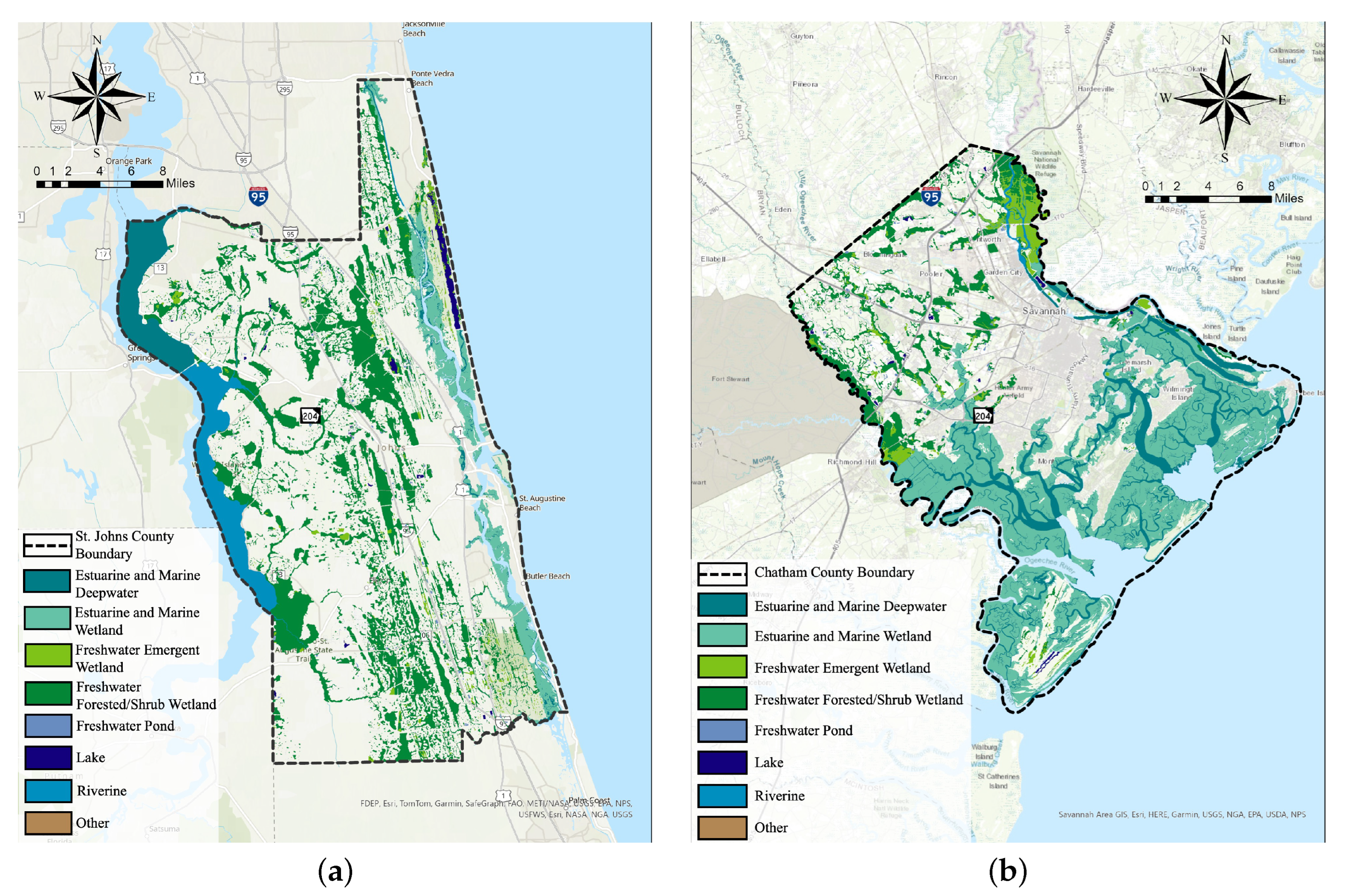
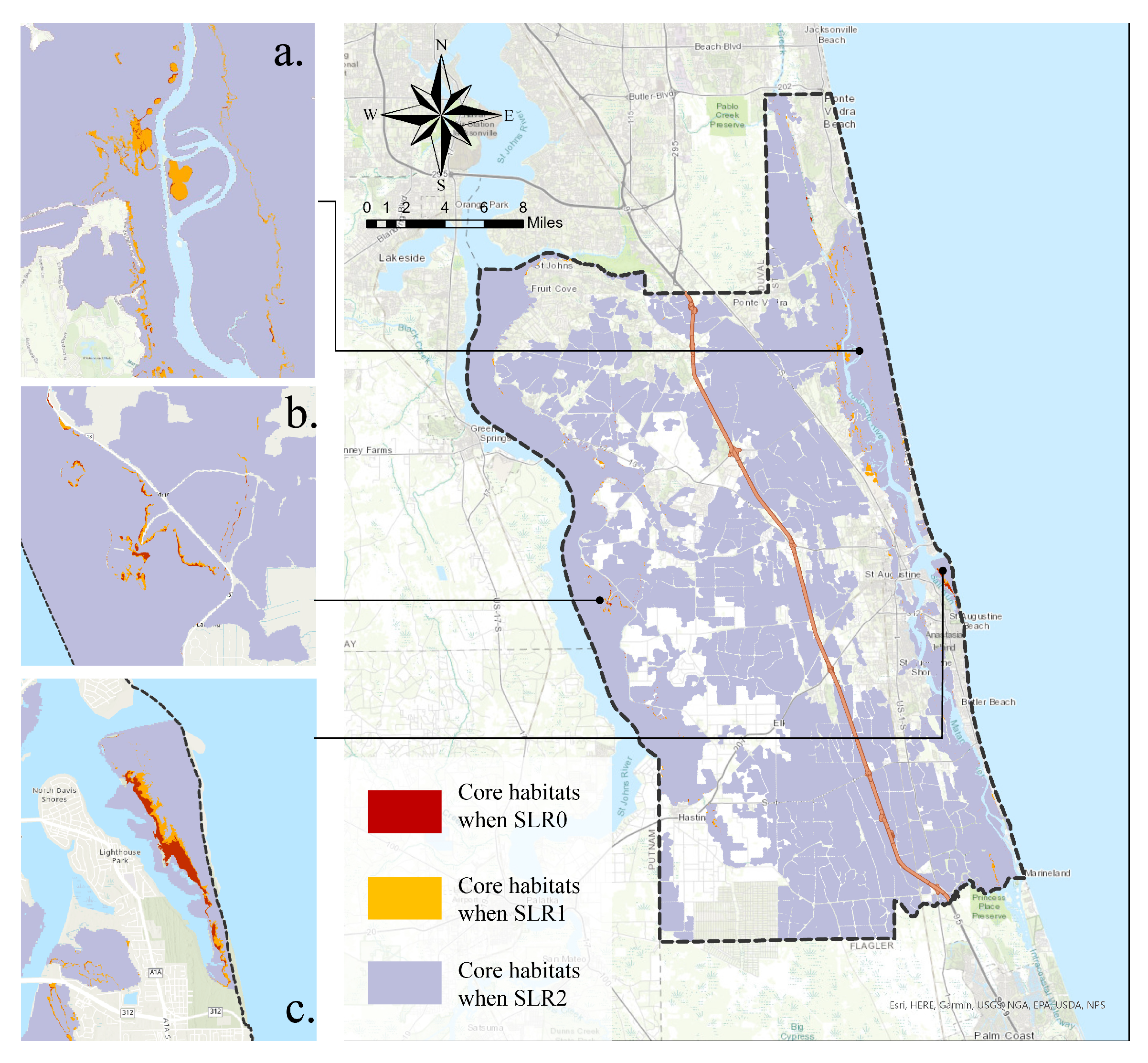

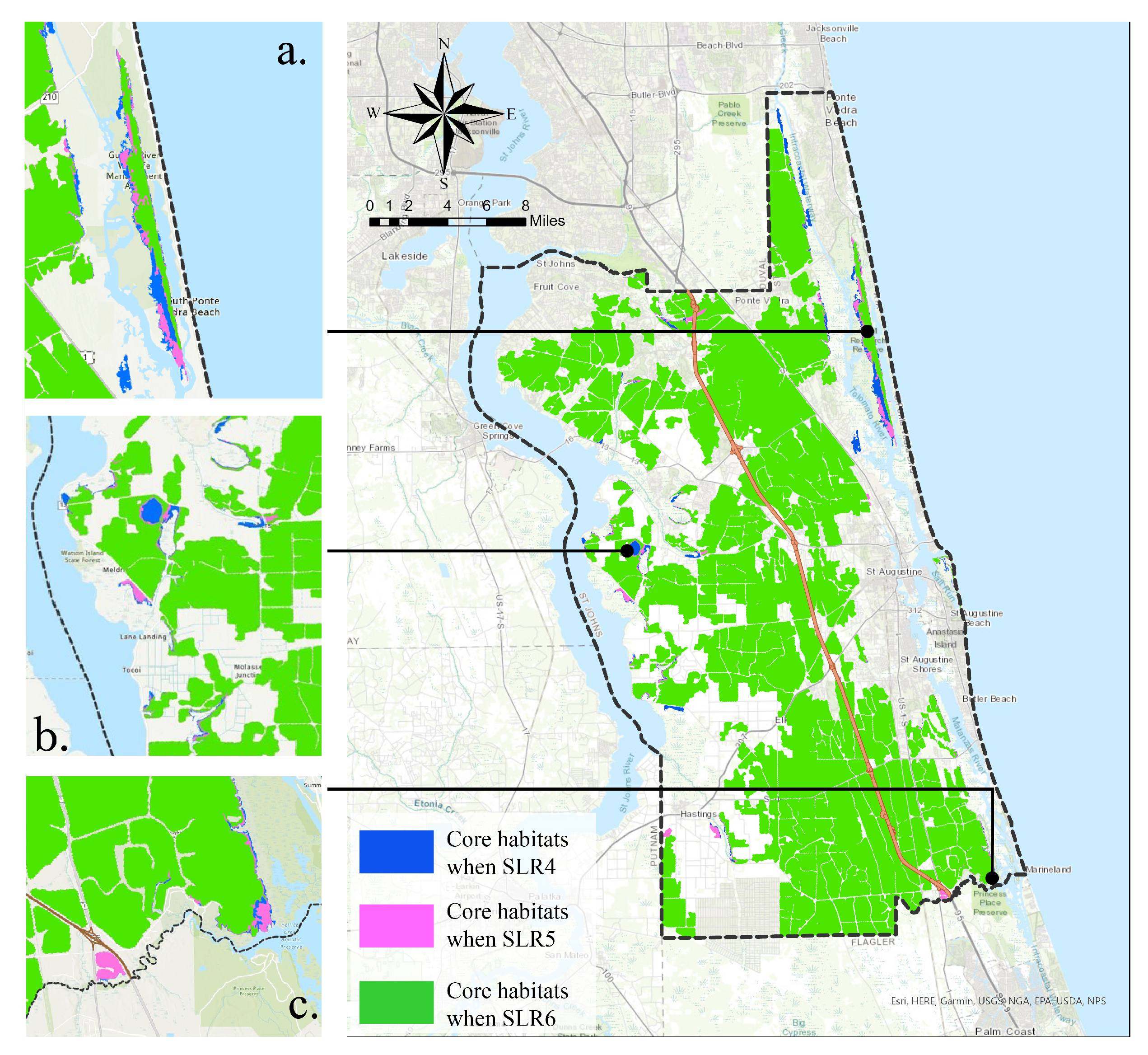
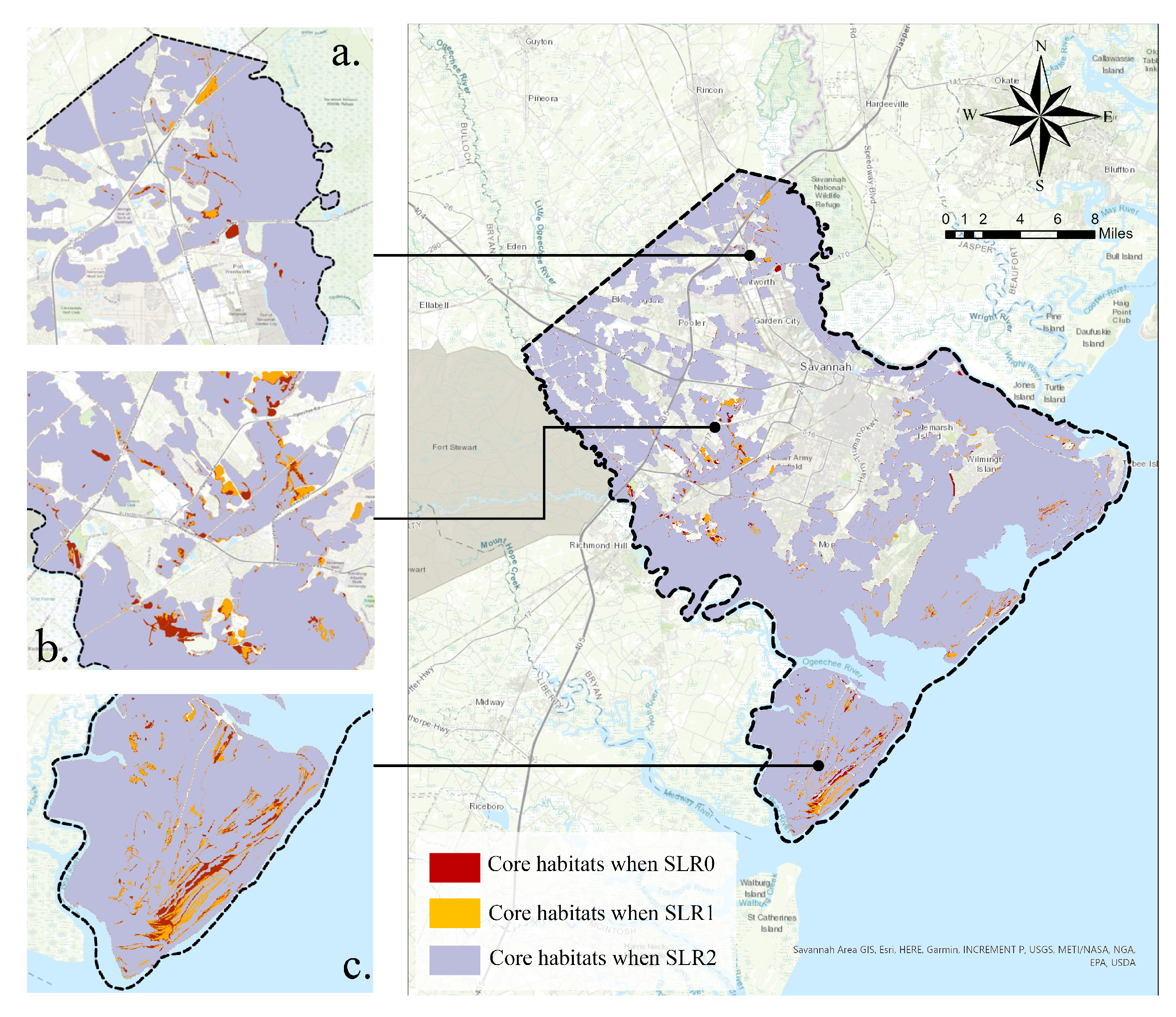
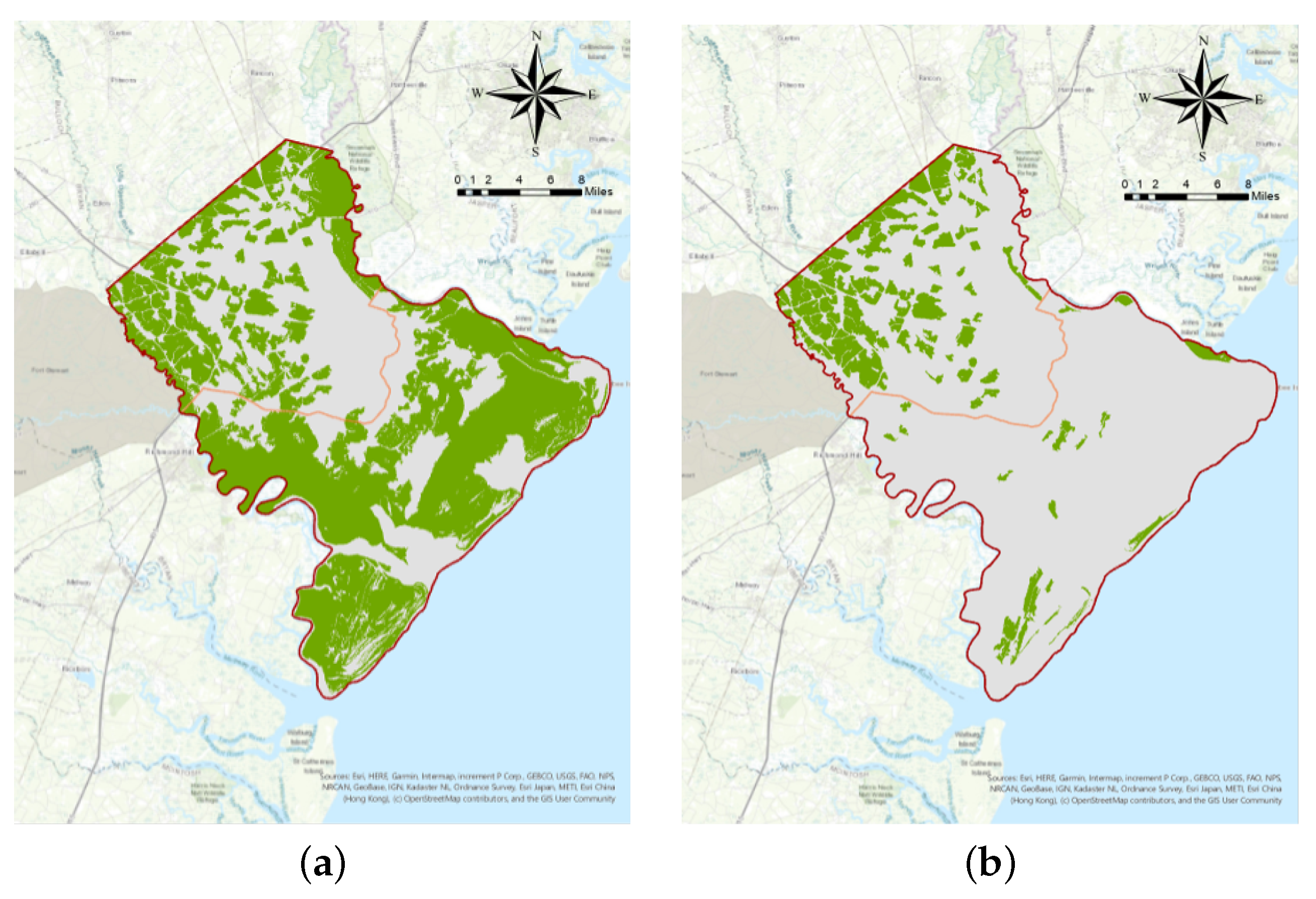
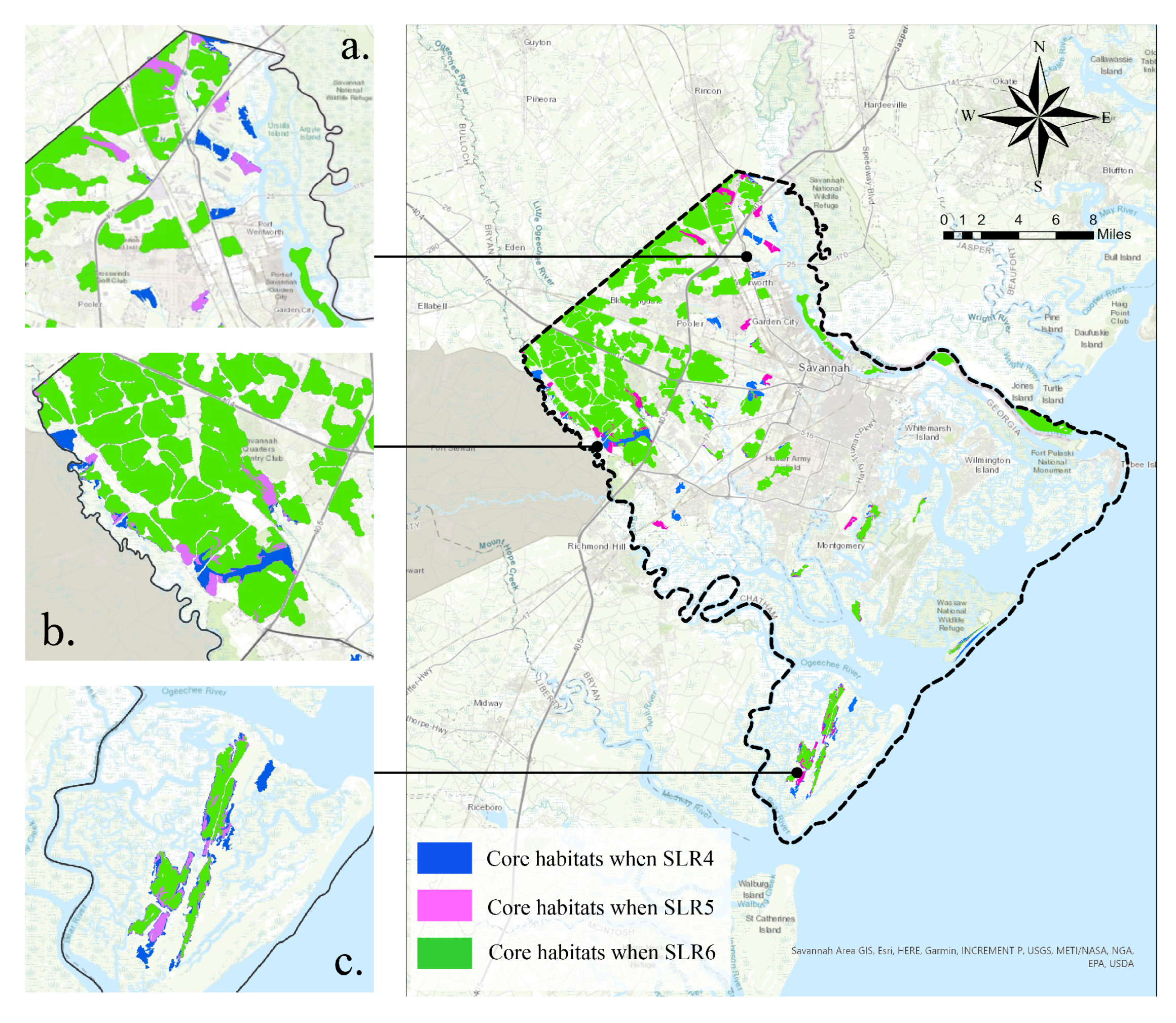

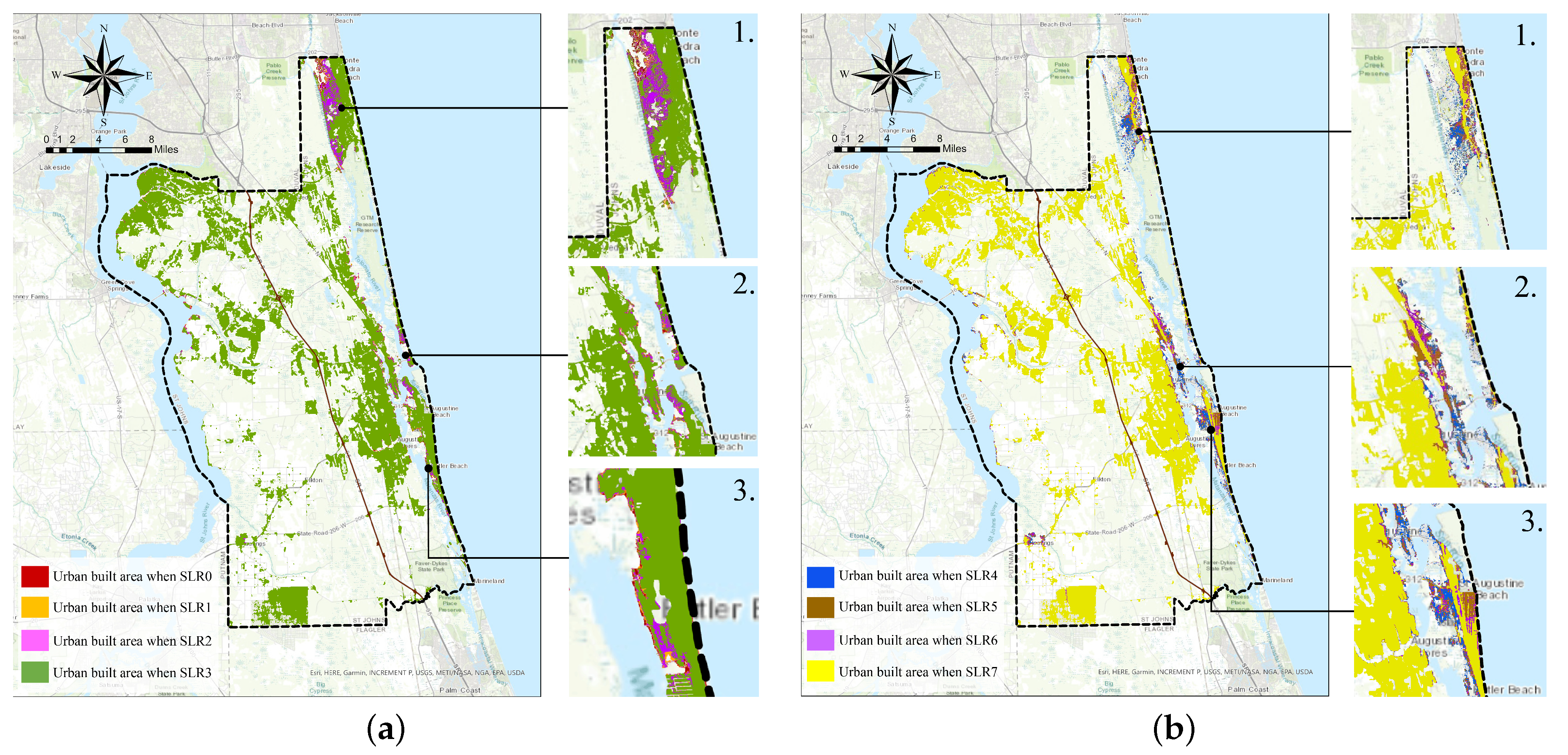

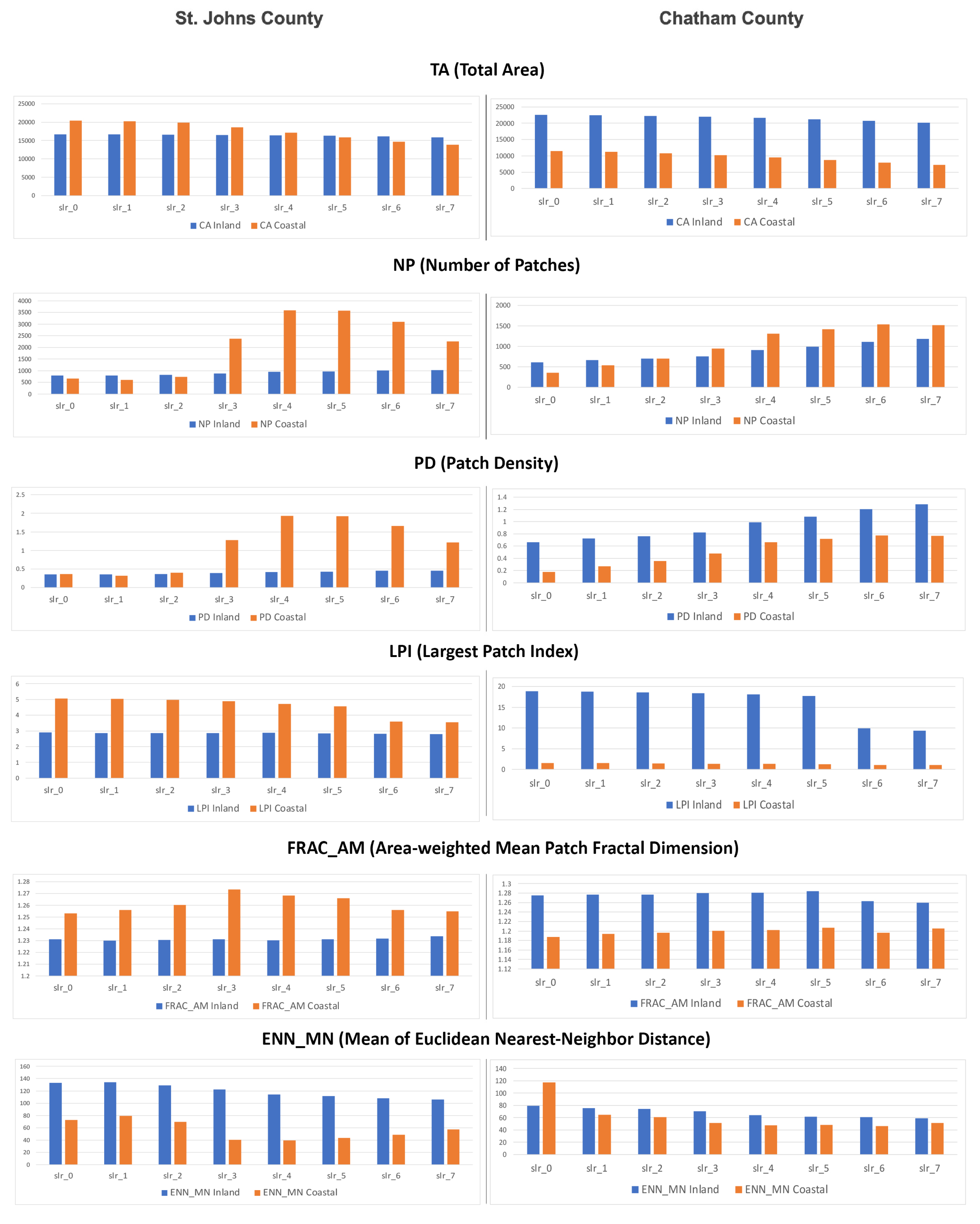
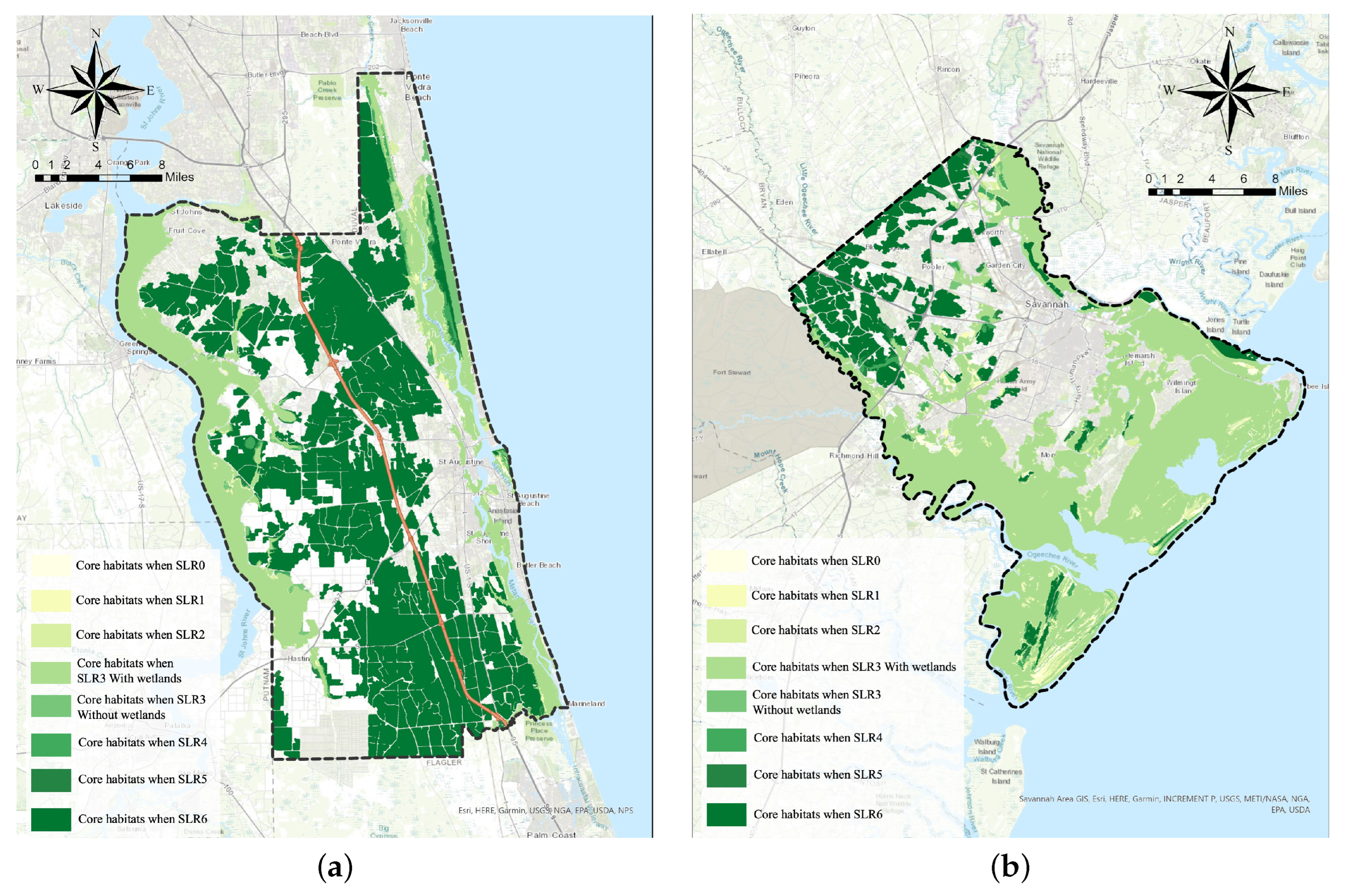
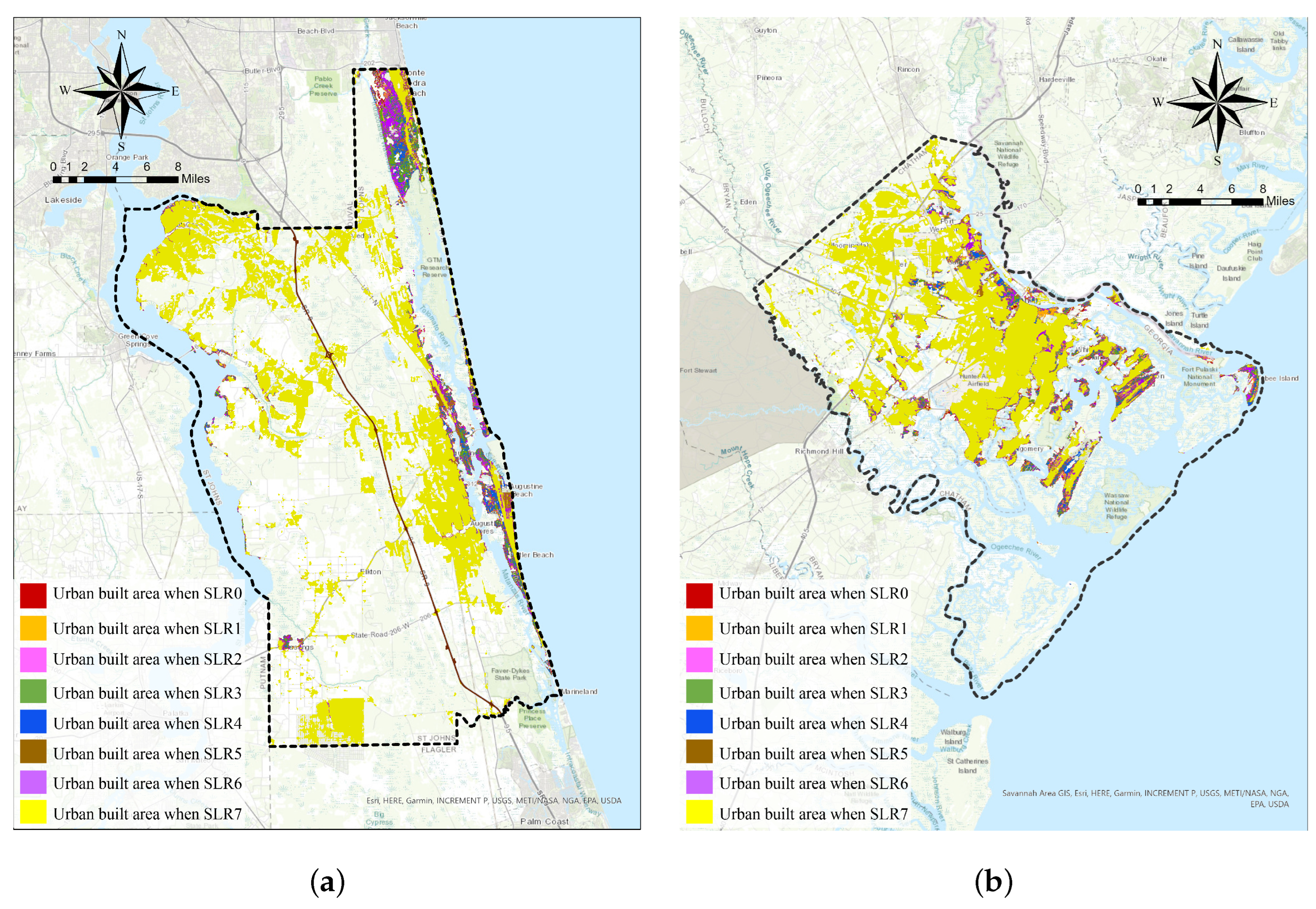
| Year | Intermediate Low | Intermediate | Intermediate High | High |
|---|---|---|---|---|
| 2020 | 0.39 | 0.39 | 0.43 | 0.43 |
| 2040 | 0.89 | 0.95 | 1.05 | 1.12 |
| 2060 | 1.41 | 1.64 | 2.03 | 2.40 |
| 2080 | 1.90 | 2.56 | 3.51 | 4.53 |
| 2100 | 2.40 | 3.90 | 5.35 | 6.99 |
| Landscape Metrics | Description | Unit | Range |
|---|---|---|---|
| Mean Euclidean nearest-neighbor distance (ENN_MN) | ENN_MN refers to the mean distance to the nearest neighboring patch of urban green infrastructures based on the edge-to-edge distance. | Meters | ENN_MN |
| Largest patch index (LPI) | LPI equals the area (m2) of the largest patch of the corresponding patch type divided by total landscape area (m2). It approaches 0 when the largest patch of the corresponding patch type is increasingly small. It is equal to 100 when the entire landscape consists of a single patch of the corresponding patch type. | % | LPI |
| Mean patch shape index (SHAPE_MN) | Mean patch shape index refers to the mean value of the patch shape index. | None | SHAPE_MN |
| Patch density (PD) | PD equals the number of patches in the landscape, divided by total landscape area (m2), multiplied by 10,000 and 100 (to convert to 100 hectares). | Number per 100 hectares | PD |
| Percentage of landscape (PLAND) | PLAND equals the area of urban green infrastructure divided by the area of built-up area. | % | PLAND |
| Percentage of like adjacencies (PLADJ) | PLADJ calculates the frequency of patches of different classes i (focal class) and k that are next to each other; it is a measure of class aggregation. | % | PLADJ |
| Landscape Metrics | Description | Unit | Range |
|---|---|---|---|
| Total area (TA) | TA sums the area of all patches in the landscape. It is the area of the observation area. | Ha | TA |
| Number of patches (NP) | NP equals the number of urban patches. | None | NP |
| Patch density (PD) | PD equals the number of patches in the landscape, divided by total landscape area (m2), multiplied by 10,000 and 100 (to convert to 100 hectares). | Number per 100 hectares | PD |
| Largest patch index (LPI) | LPI equals the area (m2) of the largest patch of the corresponding patch type divided by total landscape area (m2), multiplied by 100 (to convert to a percentage). | % | LPI |
| Area-weighted mean patch fractal dimension (FRAC_AM) | FRAC_AM equals the sum, across all urban patches. The fractal dimension of a patch equals two times the logarithm of patch perimeter (m) divided by the logarithm of patch area (m2). | None | FRAC_AM |
| Euclidean mean nearest-neighbor distance (ENN_MN) | ENN equals the distance (m) to the nearest neighboring patch of the same type, based on shortest edge-to-edge distance. Note that the edge-to-edge distances are from cell center to cell center. | Meters | ENN_MN > 0 |
| SLR Height | Number of Core Habitats | Area (km2) | Area Lost (km2) |
|---|---|---|---|
| SLR0 | 148 | 1088.9 | — |
| SLR1 | 148 | 1087.2 | 1.7 |
| SLR2 | 149 | 1080.9 | 6.3 |
| SLR3 (With wetlands) | 148 | 1071.1 | 9.8 |
| SLR3 (Without wetlands) | 153 | 800.4 | 280.5 |
| SLR4 | 148 | 773.9 | 26.5 |
| SLR5 | 146 | 762.0 | 11.9 |
| SLR6 | 147 | 752.4 | 9.6 |
| SLR Height | Number of Core Habitats | Area (km2) | Area Lost (km2) |
|---|---|---|---|
| SLR0 | 78 | 822.4 | — |
| SLR1 | 79 | 803.5 | 18.9 |
| SLR2 | 81 | 785.8 | 17.7 |
| SLR3 (With wetlands) | 83 | 768.9 | 16.9 |
| SLR3 (Without wetlands) | 94 | 191.1 | 594.7 |
| SLR4 | 89 | 178.8 | 12.3 |
| SLR5 | 81 | 165.9 | 12.9 |
| SLR6 | 79 | 154.8 | 11.1 |
Disclaimer/Publisher’s Note: The statements, opinions and data contained in all publications are solely those of the individual author(s) and contributor(s) and not of MDPI and/or the editor(s). MDPI and/or the editor(s) disclaim responsibility for any injury to people or property resulting from any ideas, methods, instructions or products referred to in the content. |
© 2024 by the authors. Licensee MDPI, Basel, Switzerland. This article is an open access article distributed under the terms and conditions of the Creative Commons Attribution (CC BY) license (https://creativecommons.org/licenses/by/4.0/).
Share and Cite
Zhao, J.; Rivero, R.G.; Madden, M. Measuring Urban and Landscape Change Due to Sea Level Rise: Case Studies in Southeastern USA. Remote Sens. 2024, 16, 2105. https://doi.org/10.3390/rs16122105
Zhao J, Rivero RG, Madden M. Measuring Urban and Landscape Change Due to Sea Level Rise: Case Studies in Southeastern USA. Remote Sensing. 2024; 16(12):2105. https://doi.org/10.3390/rs16122105
Chicago/Turabian StyleZhao, Jiyue, Rosanna G. Rivero, and Marguerite Madden. 2024. "Measuring Urban and Landscape Change Due to Sea Level Rise: Case Studies in Southeastern USA" Remote Sensing 16, no. 12: 2105. https://doi.org/10.3390/rs16122105
APA StyleZhao, J., Rivero, R. G., & Madden, M. (2024). Measuring Urban and Landscape Change Due to Sea Level Rise: Case Studies in Southeastern USA. Remote Sensing, 16(12), 2105. https://doi.org/10.3390/rs16122105








